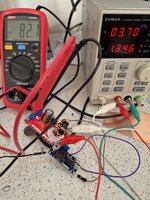TuralH
Junior Member level 2

I want to assemble a dc-dc converter that will increase the voltage from 3.7 volts to 80 volts/
I need to increase it using uc3843, but due to the fact that this PWM controller operates from 12-28 volts, I assembled another boost converter on mc34063 increased it to 27-30 volts and using LM7812 supplied 12 volts, in Ltspice the circuit works and the expected voltage is obtained at the output, but in reality and in practice will it be possible to increase the voltage using uc3843 and external NMOS from 3.7 to 80?
The duty cycle is: D≈83.76% simulated in LTspice and with 91khz of frequency. Of course there are ready-made DC-DC converters that can do this, but I would like this circuit to work too.
I will be glad for your help. Photos of the simulation are attached below.


I need to increase it using uc3843, but due to the fact that this PWM controller operates from 12-28 volts, I assembled another boost converter on mc34063 increased it to 27-30 volts and using LM7812 supplied 12 volts, in Ltspice the circuit works and the expected voltage is obtained at the output, but in reality and in practice will it be possible to increase the voltage using uc3843 and external NMOS from 3.7 to 80?
The duty cycle is: D≈83.76% simulated in LTspice and with 91khz of frequency. Of course there are ready-made DC-DC converters that can do this, but I would like this circuit to work too.
I will be glad for your help. Photos of the simulation are attached below.




